Thor Heyerdahl
Thor Heyerdahl (October 6, 1914 – April 18, 2002) was a Norwegian adventurer and ethnographer with a background in zoology, botany, and geography.
He became notable for his Kon-Tiki expedition in 1947, in which he sailed 8,000 km across the Pacific Ocean in a hand-built raft from South America to the Tuamotu Islands.
 The expedition was designed to demonstrate that ancient people could have made long sea voyages, creating contact between separate cultures.
The expedition was designed to demonstrate that ancient people could have made long sea voyages, creating contact between separate cultures.
This was linked to a diffusionist model of cultural development. Heyerdahl subsequently made other voyages designed to demonstrate the possibility of contact between widely separated ancient people.
Heyerdahl was born in Larvik, Norway, the son of master brewer Thor Heyerdahl and his wife, Alison Lyng. Heyerdahl was the lonely, only son of unhappy, estranged parents who divorced during his early childhood.
As a young child, Heyerdahl showed a strong interest in zoology.  He created a small museum in his childhood home, with a common adder (Vipera berus) as the main attraction. He studied zoology and geography at the faculty of biological science at the University of Oslo.
He created a small museum in his childhood home, with a common adder (Vipera berus) as the main attraction. He studied zoology and geography at the faculty of biological science at the University of Oslo.
At the same time, he privately studied Polynesian culture and history, consulting what was then the world’s largest private collection of books and papers on Polynesia, owned by Bjarne Kropelien, a wealthy wine merchant in Oslo.
After seven terms and consultations with experts in Berlin, a project was developed and sponsored by Heyerdahl’s zoology professors, Kristine Bonnevie and Hjalmar Broch.
He was to visit some isolated Pacific island groups and study how the local animals had found their way there.
Thor Heyerdahl and his first wife Liv took off to escape from civilization, and to “return to nature”. In spite of their academic mission, they intended to “run away to the South Seas” and never return home.
Fatu Hiva – Back to Nature
The events surrounding the stay on the Marquesas, most of the time on Fatu Hiva, were told first in a Norwegian book.
Many years later, having achieved notability with other adventures and books on other subjects, Heyerdahl published a new account of this voyage under the title Fatu Hiva.
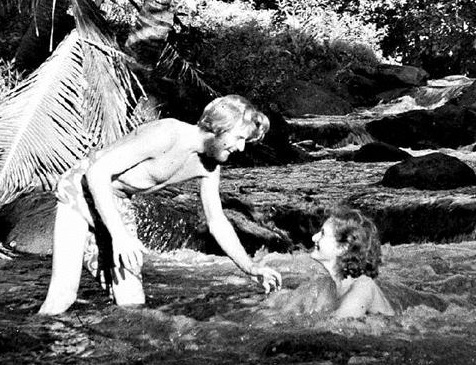 The couple arrived at Fatu Hiva in 1937 they settled in one of the small, nearly abandoned, valleys on the eastern side of the island. There, they made their thatch-covered stilted home in the valley of Uia.
The couple arrived at Fatu Hiva in 1937 they settled in one of the small, nearly abandoned, valleys on the eastern side of the island. There, they made their thatch-covered stilted home in the valley of Uia.
It was in this setting, surrounded by the ruins of the formerly glorious Marquesan civilization, that Heyerdahl first developed his theories regarding the possibility of pre-Columbian trans-oceanic contact between the pre-European Polynesians, and the peoples and cultures of South America.
During several exchanges with an elderly Marquesan man who lived in Uia, a former cannibal named Tei Tetua, Heyerdahl determined that, although prior to the arrival of Europeans, cats were not to be found in Polynesia, the Marquesans were nonetheless familiar with the creatures, and indeed, certain of the carved tiki figures seemed very much to represent felines.
To the present day, Andean peasants consider the hail-cat, “ccoa” – seen with hail running out of his eyes – a beast to be reckoned with.
 The ccoa was an important figure in the Andean cultures. This prompted Heyerdahl to ask Tei Tetua from whence his people had come.
The ccoa was an important figure in the Andean cultures. This prompted Heyerdahl to ask Tei Tetua from whence his people had come.
“From Te Fiti [The East]”, answered the old man and nodded toward that part of the horizon where the sun rose, the direction in which there was no other land except South America.
Initially, the Heyerdahls found life on Fatu Hiva to be idyllic with the abundance of fruit trees and readily available unpolluted river water.
The charm soon wore off, however, as they had to face the reality of elephantiasis-bearing mosquitos, as well as other unfamiliar tropical diseases.
The book begins with Heyerdahl’s optimistic idea that paradise could still be found. By the end of the book, Heyerdahl bitterly concludes:
“There is nothing for modern man to return to. Our wonderful time in the wilderness had given us a taste of what man had abandoned and what mankind was still trying to get even further away from… Progress today can be defined as man’s ability to complicate simplicity… Nothing in all the procedures that modern man, helped by all his modern middlemen, goes through before he earns money to buy a fish or a potato will ever be as simple as pulling it out of the water or soil.
Without the farmer and the fisherman, modern society would collapse, with all its shops and pipes and wires. The farmers and the fishermen represent the nobility of modern society; they share their crumbs with the rest of us, who run about with papers and screwdrivers attempting to build a better world without a blueprint”.
During the Second World War, Heyerdahl’s family had to live in Canada. Sentiment towards Norwegians was mixed at the time of the Nazi occupation of Norway.
Heyerdahl’s son Thor jr. relates: “We were disrespected because of lack of resistance. It was pretty tough. We felt very unpopular until we got known for the heavy water sabotage in Telemark, and when Norwegian resistance was really established and my father volunteered to join the Norwegian resistance forces.” His father trained as a parachutist and went to Europe to drive out the Nazis.
Thor jr. said farewell to his father at the age of 4 in 1942. He remembers his mother Liv saying to him and his younger brother Bjørn: “Boys, now take a close look at your father. Pinch him, smell him, I want you to know what a wonderful father you had, this may be the last time you ever see him.”
Thor Heyerdahl Jr.: “That’s the first clear recollection I have of my childhood. That made an enormous impression on me. So then, for the rest of the war, 3 years, we never got a word from my father.”
The family was reunited in Oslo in 1945, yet they saw little of Thor Heyerdahl as he arranged the Kon-Tiki expedition. Later in 1949, Thor and Liv divorced, though they retained good relations.
Thor Heyerdahl Jr. relates: “I am proud to be the son of my father, but I’m even more proud to be the son of my mother. I consider my mother superior intellectually to my father.” Though absent from much of Thor Heyerdahl’s papers, Liv participated in many of his adventures.
Kon-Tiki expedition
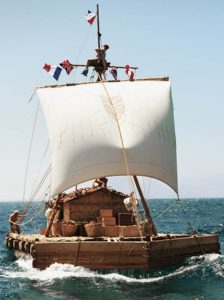 The Kon-Tiki expedition was a 1947 journey by raft across the Pacific Ocean from South America to the Polynesian islands, led by Norwegian explorer and writer Thor Heyerdahl.
The Kon-Tiki expedition was a 1947 journey by raft across the Pacific Ocean from South America to the Polynesian islands, led by Norwegian explorer and writer Thor Heyerdahl.
The raft was named Kon-Tiki after the Inca sun god, Viracocha, for whom “Kon-Tiki” was said to be an old name.
Kon-Tiki is also the name of Heyerdahl’s book; the Academy Award-winning documentary film chronicling his adventures; and the 2012 dramatized feature film nominated for the Academy Award for Best Foreign Language Film.
Heyerdahl believed that people from South America could have settled Polynesia in pre-Columbian times. His aim in mounting the Kon-Tiki expedition was to show, by using only the materials and technologies available to those people at the time, that there were no technical reasons to prevent them from having done so.
The Kon-Tiki expedition was funded by private loans, along with donations of equipment from the United States Army.
Heyerdahl and a small team went to Peru, where, with the help of dockyard facilities provided by the Peruvian authorities, they constructed the raft out of balsa logs and other native materials in an indigenous style as recorded in illustrations by Spanish conquistadores.
◊
Kon-Tiki – Trailer
◊
The trip began on April 28, 1947. Kon-Tiki demonstrated that it was possible for a primitive raft to sail the Pacific with relative ease and safety, especially to the west (with the trade winds).
The raft proved to be highly maneuverable, and fish congregated between the nine balsa logs in such numbers that ancient sailors could have possibly relied on fish for hydration in the absence of other sources of freshwater.
Heyerdahl and five companions sailed the raft for 101 days over 6900 km (4,300 miles) across the Pacific Ocean before smashing into a reef at Raroia in the Tuamotu Islands on August 7, 1947.
The crew made successful landfall and all returned safely. Heyerdahl had nearly drowned at least twice in childhood and did not take easily to water; he said later that there were times in each of his raft voyages when he feared for his life.
Thor jr. relates: “The expedition did not prove that it had been done but that it was possible, and not only possible but simple; as long as you stay afloat you drift with the trade winds and the equatorial current, you end up on the other side of the ocean, whether you want to or not.”
◊
The story of the Kon-Tiki
◊
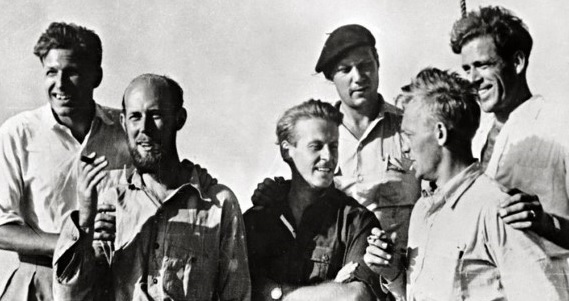 Kon-Tiki had a six-man crew, all of whom were Norwegian except for Bengt Danielsson, a Swede.
Kon-Tiki had a six-man crew, all of whom were Norwegian except for Bengt Danielsson, a Swede.
Thor Heyerdahl (1914–2002) was the expedition leader.
Erik Hesselberg (1914–1972) was the navigator and artist. He painted the large Kon-Tiki figure on the raft’s sail.
Bengt Danielsson (1921–1997) took on the role of steward, in charge of supplies and daily rations.
Knut Haugland (1917–2009) was a radio expert.
Torstein Raaby (1918–1964) was also in charge of radio transmissions.
Herman Watzinger (1910–1986) was an engineer whose area of expertise was in technical measurements.
Thor Heyerdahl’s book about his experience became a bestseller. It was published in Norwegian in 1948 as The Kon-Tiki Expedition: By Raft Across the South Seas, later reprinted as Kon-Tiki: Across the Pacific in a Raft.
It appeared with great success in English in 1950, and also in many other languages. A documentary motion picture about the expedition, also called Kon-Tiki, was produced and won an Academy Award in 1951.
The original Kon-Tiki raft is now on display in the Kon-Tiki Museum at Bygdøy in Oslo.
Thor Heyerdahl Jr. highlights the context of his father’s fame: “You must remember that in these post-war years, before science fiction, before landing on the moon…we were still worn out from the experiences of the war, death, tragedy, the world in ruins.
And here, two years after the Nazi capitulation, six handsome young men sailing with the trade wind across the world’s largest ocean, landing on a Polynesian reef with coconut palms, beautiful Hula girls, you could say that this was a dream come true.
For once, something exciting, thrilling, and adventurous happened, that had nothing to do with the war. So he got much more attention then than he would have gotten today, I’m convinced.”
Anthropologists continue to believe that Polynesia was settled from west to east, based on linguistic, physical, and genetic evidence, migration having begun from the Asian mainland.
There are controversial indications, though, of some sort of South American/Polynesian contact, most notably in the fact that the South American sweet potato is served as a dietary staple throughout much of Polynesia.
Blood samples taken in 1971 and 2008 from Easter Islanders without any European or other external descent were analyzed in a 2011 study, which concluded that the evidence supported some aspects of Heyerdahl’s hypothesis.
Theory on Polynesian origins
Heyerdahl claimed that in Incan legend there was a sun god named Con-Tici Viracocha who was the supreme head of the mythical fair-skinned people in Peru.
The original name for Viracocha was Kon-Tiki or Illa-Tiki, which means Sun-Tiki or Fire-Tiki. Kon-Tiki was a high priest and sun-king of these legendary “white men” who left enormous ruins on the shores of Lake Titicaca.
The legend continues with the mysterious bearded white men being attacked by a chief named Cari, who came from the Coquimbo Valley. They had a battle on an island in Lake Titicaca, and the fair race was massacred.
However, Kon-Tiki and his closest companions managed to escape and later arrived on the Pacific coast. The legend ends with Kon-Tiki and his companions disappearing westward out to sea.
When the Spaniards came to Peru, Heyerdahl asserted, the Incas told them that the colossal monuments that stood deserted about the landscape were erected by a race of white gods who had lived there before the Incas themselves became rulers.
The Incas described these “white gods” as wise, peaceful instructors who had originally come from the north in the “morning of time” and taught the Incas’ primitive forebears architecture as well as manners and customs.
They were unlike other Native Americans in that they had “white skins and long beards” and were taller than the Incas.
The Incas said that the “white gods” had then left as suddenly as they had come and fled westward across the Pacific. After they had left, the Incas themselves took over power in the country.
Heyerdahl said that when the Europeans first came to the Pacific islands, they were astonished that they found some of the natives to have relatively light skins and beards.
There were whole families that had pale skin, hair varying in color from reddish to blonde. In contrast, most of the Polynesians had golden-brown skin, raven-black hair, and rather flat noses.
Heyerdahl claimed that when Jakob Roggeveen first discovered Easter Island in 1722, he supposedly noticed that many of the natives were white-skinned.
Heyerdahl claimed that these people could count their ancestors who were “white-skinned” right back to the time of Tiki and Hotu Matua when they first came sailing across the sea “from a mountainous land in the east which was scorched by the sun”.
The ethnographic evidence for these claims is outlined in Heyerdahl’s book Aku Aku: The Secret of Easter Island.
Heyerdahl proposed that Tiki’s neolithic people colonized the then-uninhabited Polynesian islands as far north as Hawaii, as far south as New Zealand, as far east as Easter Island, and as far west as Samoa and Tonga around 500 AD.
They supposedly sailed from Peru to the Polynesian islands on pae-paes—large rafts built from balsa logs, complete with sails and each with a small cottage.
They built enormous stone statues carved in the image of human beings on Pitcairn, the Marquesas, and Easter Island that resembled those in Peru. They also built huge pyramids in Tahiti and Samoa with steps like those in Peru.
But all over Polynesia, Heyerdahl found indications that Tiki’s peaceable race had not been able to hold the islands alone for long.
He found evidence that suggested that seagoing war canoes as large as Viking ships and lashed together two and two had brought Stone Age Northwest American Indians to Polynesia around 1100 AD, and they mingled with Tiki’s people.
The oral history of the people of Easter Island, at least as it was documented by Heyerdahl, is completely consistent with this theory, as is the archaeological record he examined (Heyerdahl 1958).
In particular, Heyerdahl obtained a radiocarbon date of 400 AD for a charcoal fire located in the pit that was held by the people of Easter Island to have been used as an “oven” by the “Long Ears”, which Heyerdahl’s Rapa Nui sources, reciting oral tradition, identified as a white race that had ruled the island in the past (Heyerdahl 1958).
Heyerdahl further argued in his book American Indians in the Pacific that the current inhabitants of Polynesia migrated from an Asian source, but via an alternate route.
He proposes that Polynesians traveled with the wind along with the North Pacific current. These migrants then arrived in British Columbia. Heyerdahl called contemporary tribes of British Columbia, such as the Tlingit and Haida, descendants of these migrants.
Heyerdahl claimed that cultural and physical similarities existed between these British Columbian tribes, Polynesians, and the Old World source.
Heyerdahl’s claims aside, however, there is no evidence that the Tlingit, Haida or other British Columbian tribes have an affinity with Polynesians.
Heyerdahl’s theory of Polynesian origins has not gained acceptance among anthropologists.
Physical and cultural evidence had long suggested that Polynesia was settled from west to east, migration having begun from the Asian mainland, not South America.
In the late 1990s, genetic testing found that the mitochondrial DNA of the Polynesians is more similar to people from southeast Asia than to people from South America, showing that their ancestors most likely came from Asia.
A 2009 study by Norwegian researcher Erik Thorsby suggested that there was some merit to Heyerdahl’s ideas and that, while Polynesia was colonized from Asia, some contact with South America also existed.
A team including Anna-Sapfo Malaspinas (from the Natural History Museum of Denmark) analyzed the genomes of 27 native Rapanui people and found that their DNA was on average 76 percent Polynesian, 8 percent Native American and 16 percent European.
Analysis showed that: “although the European lineage could be explained by contact with white Europeans after the island was “discovered” in 1722 by Dutch sailors, the South American component was much older, dating to between about 1280 and 1495, soon after the island was first colonized by Polynesians in around 1200.”
Together with ancient skulls found in Brazil – with solely Polynesian DNA – this does suggest some pre-European-contact travel to and from South America from Polynesia.
Expedition to Rapa Nui (Easter Island)
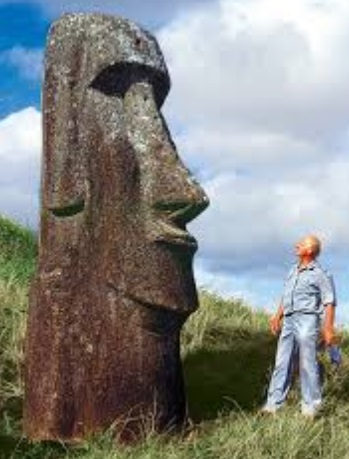 Heyerdahl’s thirst for knowledge and experience provided the driving force for new archaeological discoveries.
Heyerdahl’s thirst for knowledge and experience provided the driving force for new archaeological discoveries.
In 1955–1956, Heyerdahl organized the Norwegian Archaeological Expedition to Rapa Nui (Easter Island).
The expedition’s scientific staff included Arne Skjølsvold, Carlyle Smith, Edwin Ferdon, Gonzalo Figueroa, and William Mulloy.
Heyerdahl and the professional archaeologists who traveled with him spent several months on Rapa Nui investigating several important archaeological sites.
Highlights of the project include experiments in the carving, transport, and erection of the notable moai, as well as excavations at such prominent sites as Orongo and Poike.
The expedition published two large volumes of scientific reports (Reports of the Norwegian Archaeological Expedition to Easter Island and the East Pacific) and Heyerdahl later added a third (The Art of Easter Island).
Heyerdahl’s popular book on the subject, Aku-Aku was another international best-seller.
In Easter Island: The Mystery Solved (Random House, 1989), Heyerdahl offered a more detailed theory of the island’s history.
Based on native testimony and archaeological research, he claimed the island was originally colonized by Hanau eepe (“Long Ears”), from South America, and that Polynesians Hanau momoko (“Short Ears”) arrived only in the mid-16th century; they may have come independently or perhaps were imported as workers.
According to Heyerdahl, something happened between Admiral Roggeveen’s discovery of the island in 1722 and James Cook’s visit in 1774; while Roggeveen encountered white, Indian, and Polynesian people living in relative harmony and prosperity, Cook encountered a much smaller population consisting mainly of Polynesians and living in privation.
 Heyerdahl notes the oral tradition of an uprising of “Short Ears” against the ruling “Long Ears”.
Heyerdahl notes the oral tradition of an uprising of “Short Ears” against the ruling “Long Ears”.
The “Long Ears” dug a defensive moat on the eastern end of the island and filled it with kindling.
During the uprising, Heyerdahl claimed, the “Long Ears” ignited their moat and retreated behind it, but the “Short Ears” found a way around it, came up from behind, and pushed all but two of the “Long Ears” into the fire.
This moat was found by the Norwegian expedition and it was partly cut down into the rock. Layers of fire were revealed but no fragments of bodies.
As for the origin of the people of Easter Island DNA tests have shown a connection to South America, critics conjecture that this was a result of recent events, but whether this is inherited from a person coming in later times is hard to know.
If the story that (almost) all long-ears were killed in a civil war is true, as the islanders’ story goes, it would be expected that the statue-building South American bloodline would have been nearly totally destroyed, leaving, for the most part, the invading Polynesian bloodline.
Rapa Nui people are grateful to Heyerdahl for bringing their history to the attention of the world, and archaeologists Sonia Haoa and Sergio Rapu, like many other colleagues, appreciated his love of tackling big, complex questions, and encouraging others to do the same.
Boats Ra and Ra II
In 1969 and 1970, Heyerdahl built two boats from papyrus and attempted to cross the Atlantic Ocean from Morocco in Africa.
Based on drawings and models from ancient Egypt, the first boat, named Ra (after the Egyptian Sun god), was constructed by boat builders from Lake Chad using papyrus reed obtained from Lake Tana in Ethiopia and launched into the Atlantic Ocean from the coast of Morocco.
The Ra crew included Thor Heyerdahl (Norway), Norman Baker (USA), Carlo Mauri (Italy), Yuri Senkevich (USSR), Santiago Genoves (Mexico), Georges Sourial (Egypt), and Abdullah Djibrine (Chad).
Only Heyerdahl and Baker had sailing and navigation experiences. 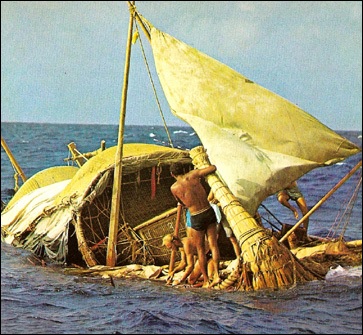 After a number of weeks, Ra took on water.
After a number of weeks, Ra took on water.
The crew discovered that a key element of the Egyptian boat building method had been neglected, a tether that acted as a spring to keep the stern high in the water while allowing for flexibility.
Water and storms eventually caused it to sag and break apart after sailing more than 6440 km (4000 miles). The crew was forced to abandon Ra, some hundred miles before the Caribbean islands, and was saved by a yacht.
The following year, 1970, a similar vessel, Ra II, was built of papyrus by Demetrio, Juan, and Jose Limachi from Lake Titicaca in Bolivia and likewise set sail across the Atlantic from Morocco, this time with great success. 
The crew was mostly the same; though Djibrine had been replaced by Kei Ohara from Japan and Madani Ait Ouhanni from Morocco.
The boat became lost and was the subject of a UN search and rescue mission.
The search included international assistance including people as far afield as Loo-Chi Hu of New Zealand.
The boat reached Barbados, thus demonstrating that mariners could have dealt with trans-Atlantic voyages by sailing with the Canary Current. The Ra II is now in the Kon-Tiki Museum in Oslo, Norway.
The book The Ra Expeditions and the film documentary Ra (1972) were made about the voyages.
Apart from the primary aspects of the expedition, Heyerdahl deliberately selected a crew representing a great diversity in race, nationality, religion and political viewpoint in order to demonstrate that at least on their own little floating island, people could cooperate and live peacefully.
Additionally, the expedition took samples of marine pollution and presented their report to the United Nations.
Tigris
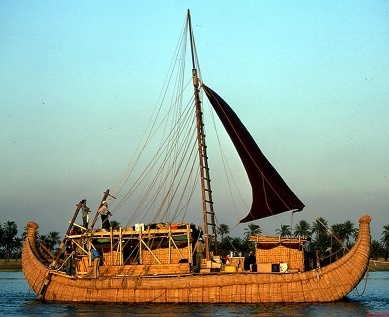 Heyerdahl built yet another reed boat, Tigris, which was intended to demonstrate that trade and migration could have linked Mesopotamia with the Indus Valley Civilization in what is now Pakistan and western India.
Heyerdahl built yet another reed boat, Tigris, which was intended to demonstrate that trade and migration could have linked Mesopotamia with the Indus Valley Civilization in what is now Pakistan and western India.
The Tigris was crewed by eleven men: Thor Heyerdahl (Norway), Norman Baker (USA), Carlo Mauri (Italy), Yuri Senkevich (USSR), Germán Carrasco (Mexico), Hans Petter Bohn (Norway), Rashad Nazar Salim (Iraq), Norris Brock (USA), Toru Suzuki (Japan), Detlef Soitzek (Germany), and Asbjørn Damhus (Denmark).
Tigris was built in Iraq and sailed with its international crew through the Persian Gulf to Pakistan and made its way into the Red Sea.
After about five months at sea and still remaining seaworthy, the Tigris was deliberately burnt in Djibouti, on April 3, 1978, as a protest against the wars raging on every side in the Red Sea and the Horn of Africa.
In his Open Letter to the UN Secretary-General Kurt Waldheim, Heyerdahl explained his reasons:
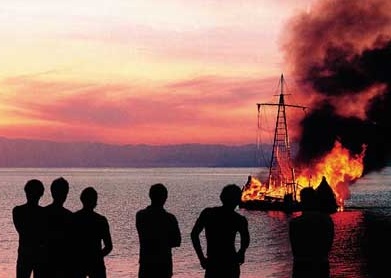 Today we burn our proud ship … to protest against inhuman elements in the world of 1978 …
Today we burn our proud ship … to protest against inhuman elements in the world of 1978 …
Now we are forced to stop at the entrance to the Red Sea. Surrounded by military airplanes and warships from the world’s most civilized and developed nations, we have been denied permission by friendly governments, for reasons of security, to land anywhere, but in the tiny, and still neutral, Republic of Djibouti.
Elsewhere around us, brothers and neighbors are engaged in homicide with means made available to them by those who lead humanity on our joint road into the third millennium.
To the innocent masses in all industrialized countries, we direct our appeal. We must wake up to the insane reality of our time …
We are all irresponsible unless we demand from the responsible decision-makers that modern armaments must no longer be made available to people whose former battle axes and swords our ancestors condemned.
Our planet is bigger than the reed bundles that have carried us across the seas, and yet small enough to run the same risks unless those of us still alive open our eyes and minds to the desperate need for intelligent collaboration to save ourselves and our common civilization from what we are about to convert into a sinking ship.
In the years that followed, Heyerdahl was often outspoken on issues of international peace and the environment.
“The Search for Odin” in Azerbaijan and Russia
Heyerdahl made four visits to Azerbaijan in 1981, 1994, 1999, and 2000. Heyerdahl had long been fascinated with the rock carvings that date back to about 8th-7th millennia BCE at Gobustan (about 30 miles west of Baku).
He was convinced that their artistic style closely resembles the carvings found in his native Norway.
The ship designs, in particular, were regarded by Heyerdahl as similar and drawn with a simple sickle-shaped line, representing the base of the boat, with vertical lines on deck, illustrating crew or, perhaps, raised oars.
Based on this and other published documentation, Heyerdahl proposed that Azerbaijan was the site of an ancient advanced civilization.
He believed that natives migrated north through waterways to present-day Scandinavia using ingeniously constructed vessels made of skins that could be folded like cloth.
When voyagers traveled upstream, they conveniently folded their skin boats and transported them via pack animals.
On Heyerdahl’s visit to Baku in 1999, he lectured at the Academy of Sciences about the history of ancient Nordic Kings.
He spoke of a notation made by Snorri Sturluson, a 13th-century historian-mythographer in Ynglinga Saga, which relates that “Odin (a Scandinavian god who was one of the kings) came to the North with his people from a country called Aser.” (see also House of Ynglings and Mythological kings of Sweden).
Heyerdahl accepted Snorri’s story as literal truth and believed that a chieftain led his people in a migration from the east, westward, and northward through Saxony, to Fyn in Denmark, and eventually settling in Sweden.
Heyerdahl claimed that the geographic location of the mythic Aser or Æsir matched the region of contemporary Azerbaijan – “east of the Caucasus mountains and the Black Sea”.
“We are no longer talking about mythology,” Heyerdahl said, “but of the realities of geography and history. Azerbaijanis should be proud of their ancient culture. It is just as rich and ancient as that of China and Mesopotamia.”
In September 2000, Heyerdahl returned to Baku for the fourth time and visited the archeological dig in the area of the church of Kish.
One of the last projects of his life, ‘The Search for Odin’, was a sudden revision of his Odin hypothesis, in furtherance of which he initiated 2001–2002 excavations in Azov, Russia, near the Sea of Azov at the northeast of the Black Sea.
He searched for the remains of a civilization to match the account of Odin in Snorri Sturlusson, quite a bit north of his original target of Azerbaijan on the Caspian Sea only two years earlier.
This project generated harsh criticism and accusations of pseudo-science from historians, archaeologists, and linguists in Norway, who accused Heyerdahl of selective use of sources, and a basic lack of scientific methodology in his work.
His central claims were based on similarities of names in Norse mythology and geographic names in the Black Sea region, e.g. Azov and Æsir, Udi and Odin, Tyr and Turkey.
Philologists and historians reject these parallels as mere coincidences, and also anachronisms, for instance, the city of Azov did not have that name until over 1000 years after Heyerdahl claims the Æsir dwelt there.
The controversy surrounding the Search for Odin project was in many ways typical of the relationship between Heyerdahl and the academic community.
His theories rarely won any scientific acceptance, whereas Heyerdahl himself rejected all scientific criticism and concentrated on publishing his theories in popular books aimed at the general public.
Other projects
Heyerdahl also investigated the mounds found on the Maldive Islands in the Indian Ocean. There, he found sun-oriented foundations and courtyards, as well as statues with elongated earlobes.
Heyerdahl believed that these finds fit with his theory of a seafaring civilization that originated in what is now Sri Lanka, colonized the Maldives, and influenced or founded the cultures of ancient South America and Easter Island. His discoveries are detailed in his book The Maldive Mystery.
In 1991, he studied the Pyramids of Güímar on Tenerife and declared that they were not random stone heaps but pyramids.
Based on the discovery made by the astrophysicists Aparicio, Belmonte, and Esteban, from the Instituto de Astrofísica de Canarias that the “pyramids” were astronomically oriented and being convinced that they were of ancient origin, he claimed that the ancient people who built them were most likely sun worshipers.
Heyerdahl advanced a theory according to which the Canaries had been the bases of ancient shipping between America and the Mediterranean.
Heyerdahl was also an active figure in Green politics. He was the recipient of numerous medals and awards. He also received 11 honorary doctorates from universities in the Americas and Europe.
Death
In subsequent years, Heyerdahl was involved with many other expeditions and archaeological projects. He remained best known for his boat-building, and for his emphasis on cultural diffusionism.
He died, aged 87, from a brain tumor. After receiving the diagnosis he prepared for dying by refusing to eat or take medication.
The Norwegian government granted Heyerdahl the honor of a state funeral in the Oslo Cathedral on April 26, 2002. His cremated remains lie in the garden of his family’s home in Colla Micheri.
Legacy
Although much of his work remains unaccepted within the scientific community, Heyerdahl increased public interest in ancient history and anthropology.
He also showed that long-distance ocean voyages were possible with ancient designs. As such, he was a major practitioner of experimental archaeology.
Heyerdahl was open-minded and always fair, even when the results failed to prove his theories.
He encouraged conservation and environmental awareness, had a wide public that he was very conscious of, and enjoyed the undisputed celebrity status of a world figure and Norwegian national treasure.
Heyerdahl’s grandson, Olav Heyerdahl, retraced his grandfather’s Kon-Tiki voyage in 2006 as part of a six-member crew.
The voyage, organized by Torgeir Higraff and called the Tangaroa Expedition, was intended as a tribute to Heyerdahl, an effort to better understand navigation via centerboards (“guara”) as well as a means to monitor the Pacific Ocean’s environment.
The Thor Heyerdahl Institute was established in 2000. Heyerdahl himself agreed to the founding of the institute and it aims to promote and continue to develop Heyerdahl’s ideas and principles. The institute is located in Heyerdahl’s birth town in Larvik, Norway.
The Kon-Tiki Museum on the Bygdøy peninsula in Oslo, Norway houses vessels and maps from the Kon-Tiki expedition, as well as a library with about 8000 books.
In Larvik, the birthplace of Heyerdahl, the municipality began a project in 2007 to attract more visitors.
Since then, they have purchased and renovated Heyerdahl’s childhood home, arranged a yearly raft regatta in his honor at the end of summer, and begun to develop a Heyerdahl center.
In spite of much criticism, a recent scientific investigation that compares the DNA of some of the Polynesian islands with natives from Peru suggests that there is some merit to Heyerdahl’s ideas and that while Polynesia was colonized from Asia, some contact with South America also existed.
Google honored Heyerdahl on his 100th birthday by making a Google Doodle.
Heyerdahl received numerous awards and governmental, state and academic honors and honorary degrees.
Books:
På Jakt efter Paradiset (Hunt for Paradise), 1938; Fatu-Hiva: Back to Nature (changed title in English in 1974).
The Kon-Tiki Expedition: By Raft Across the South Seas (also known as Kon-Tiki: Across the Pacific in a Raft), 1948.
American Indians in the Pacific: The Theory Behind the Kon-Tiki Expedition (Chicago: Rand McNally, 1952), 821 pages.
Aku-Aku: The Secret of Easter Island.
Sea Routes to Polynesia: American Indians and Early Asiatics in the Pacific (Chicago: Rand McNally, 1968), 232 pages.
Early Man and the Ocean: The Beginning of Navigation and Seaborn Civilizations
The Tigris Expedition: In Search of Our Beginnings
Easter Island: The Mystery Solved
Green Was the Earth on the Seventh Day: Memories and Journeys of a Lifetime
Pyramids of Tucume: The Quest for Peru’s Forgotten City
Skjebnemote vest for havet [Fate Meets West of the Ocean], 1992 (in Norwegian and German only) the Native Americans tell their story, white and bearded Gods, infrastructure was not built by the Inkas but their more advanced predecessors.
In the Footsteps of Adam: A Memoir (the official edition is Abacus, 2001, translated by Ingrid Christophersen) ISBN 0-349-11273-8
Ingen Grenser (No Boundaries, Norwegian only), 1999
Jakten på Odin (Theories about Odin, Norwegian only), 2001
Arnold Jacoby: Senor Kon-Tiki: The Biography of Thor Heyerdahl
Christopher Ralling: The Kon-Tiki Man: Thor Heyerdahl, 1990
Quotes by Thor Heyerdahl
—
Borders: I have never seen one. But I have heard they exist in the minds of some people.
—
It is also rarer to find happiness in a man surrounded by the miracles of technology than among people living in the desert of the jungle and who by the standards set by our society would be considered destitute and out of touch.
—
Any scientist can testify that a dead ocean means a dead planet …. No national law, no national precautions can save the planet. The ocean, more than any other part of our planet, … is a classic example of the absolute need for international global action.
—
For every minute, the future is becoming the past.
—
In my experience, it is rarer to find a really happy person in a circle of millionaires than among vagabonds.
—
One learns more from listening than speaking. And both the wind and the people who continue to live close to nature still have much to tell us that we cannot hear within university walls.
—
Circumstances cause us to act the way we do. We should always bear this in mind before judging the actions of others. I realized this from the start of World War II.
—
Progress is man’s ability to complicate simplicity.
—
It is progress when a centuries-old oak is cut down to give space for a road sign.
—
It is progress when weapons are improved to kill more people at a longer range.
—
We must wake up to the insane reality of our time. We are all irresponsible unless we demand from the responsible decision-makers that modern armaments must no longer be made available to people whose former battle axes and swords our ancestors condemned.
—
Once in a while, you find yourself in an odd situation. You get into it by degrees and in the most natural way but, when you are right in the midst of it, you are suddenly astonished and ask yourself how in the world it all came about.
—
I was in uniform for four years, and I know that heroism doesn’t occur from taking orders, but rather from people who through their own willpower and strength are willing to sacrifice their lives for an idea.
—
I don’t believe in war as a solution to any kind of conflict, nor do I believe in heroism on the battlefield because I have never seen any.
—
Therefore, I feel convinced that any political picture can be changed to suit the needs of the powers that be.


